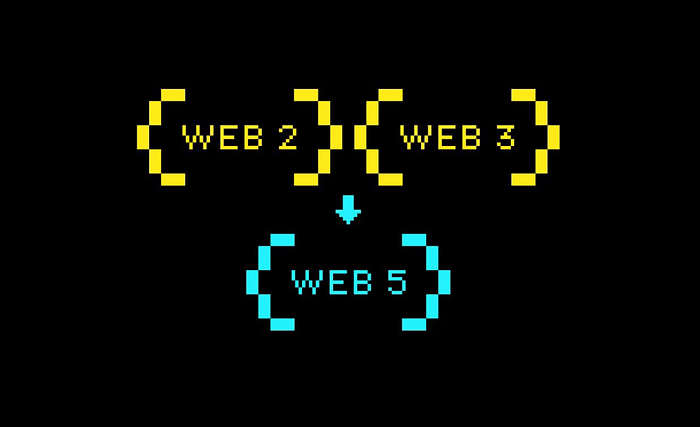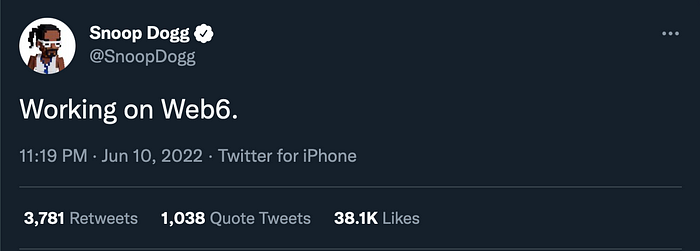

Web3 Is Dead. Long Live Web5.
source link: https://stephenmoore.medium.com/web3-is-dead-long-live-web5-4bc4fb391065
Go to the source link to view the article. You can view the picture content, updated content and better typesetting reading experience. If the link is broken, please click the button below to view the snapshot at that time.
Web3 Is Dead. Long Live Web5.
With its image tarnished by monkey jpegs and shitcoins, it seems we’re already moving on from Web3

Web3 was heralded as “the future of the internet.”
Well, less heralded and more shouted about really loudly by ‘crypto bros.’
But, as quickly as it arrived to champion itself as the next iteration of the internet, it looks like it’s dead in the water. It has been hit by scandals, turbulence and crashes galore:
- The cryptocurrencies that help form the backbone of Web 3.0 have crashed badly. Bitcoin is down 66% from its all-time high of $66,935. Ethereum has plummeted from $2130 to $1117 this past month alone. The overall cryptocurrency market dropped below $900 billion, from a peak of roughly $3 trillion six months ago. The worst is likely still to come.
- Ridiculous gas fees have made even the most basic of transactions on the blockchains used by Web3 completely unsustainable.
- Terra, Luna and other dollar pegs have collapsed, hurting the overall crypto markets. Meanwhile, Celsius, a crypto lender with backing from serious VC players and Canada’s second-largest pension fund, and Binance, a crypto marketplace, have been withholding people’s money and coins. (i.e., they’re on the verge of collapsing.)
- NFT sales have continued to fall and are fading from public interest at record speed.
Like everything involved in the crypto/blockchain space, real use cases for few and far between. Instead of captivating examples of the future, Web3’s image has become tarnished as the home for monkey profile pictures and shitcoins while failing to become decentralized (the whole concept is controlled by VCs).
In sum, it hasn’t lived up to its promise, and it seems that the damage is irreparable, leaving the entire Web3 iteration in the gutter.
Step forward our new saviour — Web5
Fear not though, as hero awaits to drag us out of the Web3 hellscape. Wasting no time in moving on, Jack Dorsey revealed his plan to save the future of the internet.
In fairness, Dorsey has long been a critic of Web3, believing that the influx of VC capital and silicon valley insiders has created a platform that is anything but decentralized. In a tweet that upset believers and VCs alike (he was promptly blocked by Marc Andreessen, which much have been devastating), Dorsey argued, “You don’t own “Web3.” The VCs and their LPs do. It will never escape their incentives. It’s ultimately a centralized entity with a different label.”
And so, on Jun 10, in a very Elon-like fashion, Dorsey spontaneously announced the next vision of the internet — Web5. The project will be worked on by TBD, a unit within Dorsey’s company Block (formerly Square).
The pitch, in simple terms, is that Web5 will offer a decentralized internet on which users control their own data and identity. And it’s based on Bitcoin. Sound familiar? The official definition given in the presentation pack tries very, very hard to sell its decentralizedness. “Web5 is a Decentralized Web Platform that enables developers to leverage Decentralized Identifiers, Verifiable Credentials, and Decentralized Web Nodes to write Decentralized Web Apps, returning ownership and control over identity and data to individuals.”
The Web5 vision would be permission-less, open, with no third-party validators, and without token. As to what that means here on planet earth, your guess is as good as mine. It’s about identity. Ownership. Blockchains. Bitcoin. But, it’s different.
Side note: For those wondering what happened to Web4, it appears to have been skipped entirely, forever destined to wish it had the chance to show the world what it could have been. (Likely, it would have also been shit.) The thinking goes that, as this new iteration is a culmination of Web2 and Web3, simple maths and common sense adds up to 5. Or something.
While the announcement was spontaneous, Dorsey and his team have clearly had this simmering away in the background for some time. On the current state of Web5 and its development, Daniel Buchner, part of Block’s Decentralized Identity team, said, “We’re currently finishing out the technical components of Web5 (they’re not far from completion).”
Whether Web5 is the defining project that allows the internet to become truly decentralized remains to be seen. For that to happen, it will have to a) be useful to users and b) convince everyone to drop the countless projects, products, services, coins, blockchains and websites associated with Web3 being developed as I write this.
But worryingly for Dorsey and the incoming flood of creators jumping on the bandwagon, it may already be too late for Web5.
Someone is already planning Web6.

The bigger picture is that the next months and years in the evolution of the internet will be hectic and far less stable than the progression and transition from Web 1.0 to Web 2.0. After all,
- Web1 lasted about 13 years, from around 1991 to 2004
- Web2 lasted about 15 years, from 2004 to around 2021 (though the Web3 term was first used in 2014, it only really gained traction years later.)
- Web3 has lasted, well, about a year.
- Web4 has lasted zero days.
And now it seems the silicon valley billionaires are intent on turning the whole thing into a reckless startup-esque race, each disrupting the next iteration until they either crack it. Or destroy it completely.
One thing is certain, though — Web5 won’t be around long either.
Recommend
About Joyk
Aggregate valuable and interesting links.
Joyk means Joy of geeK